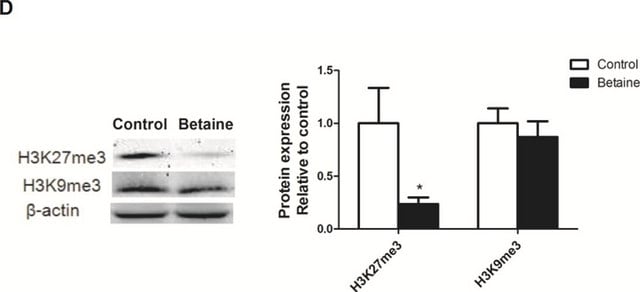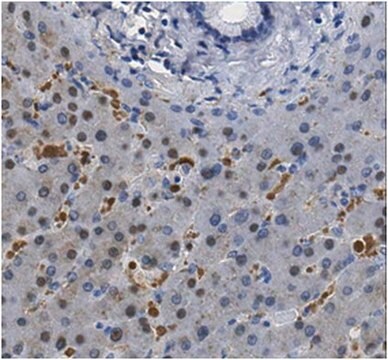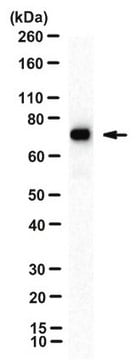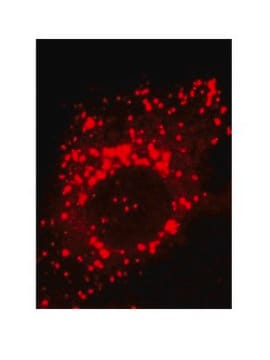MABS1920
Anti-IRF-9 Antibody, clone 6F1-H5
clone 6F1-H5, from mouse
同義詞:
Interferon regulatory factor 9, IFN-alpha-responsive transcription factor subunit, ISGF3 p48 subunit, Interferon-stimulated gene factor 3 gamma, ISGF-3 gamma, Transcriptional regulator ISGF3 subunit gamma
登入查看組織和合約定價
全部照片(1)
About This Item
分類程式碼代碼:
12352203
eCl@ss:
32160702
NACRES:
NA.41
推薦產品
生物源
mouse
品質等級
抗體表格
purified immunoglobulin
抗體產品種類
primary antibodies
無性繁殖
6F1-H5, monoclonal
物種活性
mouse
應無反應活性
human
包裝
antibody small pack of 25 μg
技術
ChIP: suitable
western blot: suitable
同型
IgG2aκ
NCBI登錄號
UniProt登錄號
運輸包裝
ambient
目標翻譯後修改
unmodified
基因資訊
mouse ... Irf9(16391)
一般說明
Interferon regulatory factor 9 (UniProt: Q61179; also known as IRF-9, IFN-alpha-responsive transcription factor subunit, ISGF3 p48 subunit, Interferon-stimulated gene factor 3 gamma, ISGF-3 gamma, Transcriptional regulator ISGF3 subunit gamma) is encoded by the Irf9 (also known as Isgf3g) gene (Gene ID: 16391) in murine species. IRF-9 is a transcription factor that mediates signaling by interferon-alpha and beta. It contains 1 IRF tryptophan pentad repeat DNA-binding domain Following binding of these interferons to cell surface receptors, JAK kinases (Tyk2 ad JAK1) are activated that lead to tyrosine phosphorylation of STAT1 and STAT2. IRF-9 then associates with phosphorylated STAT1:STAT2 dimer to form the interferon-stimulated gene factor 3 (ISFG3) complex that translocates to the nucleus and binds to the interferon stimulated response element (ISRE) to activate the transcription of interferon-stimulated genes. In mice, ablation of IRF-9 is shown to block the proliferation and migration of vascular smooth muscle cells (VSMC) and attenuates intimal thickening in response to injury. On the other hand, IRF-9 gain-of-function is reported to promote VSMC proliferation and migration that can aggravates arterial narrowing. (Ref.: Zhang, SM et al (2015). Nat Commun. 6:6882).
特異性
Clone 6F1-H5 detects interfereon regulatory factor 9 (IRF-9) of 51 kDa in murine species. May also detect shorter variants of IRF-9.
免疫原
Epitope: N-terminus
His-tagged full length recombinant longer version (465 amino acids) of murine Interferon regulatory factor 9.
應用
Anti-IRF-9, clone 6F1-H5, Cat. No. MABS1920, is a mouse monoclonal antibody that detects Interferon regulatory factor 9 (IRF-9). It has been tested for use in chromatin Immunoprecipitation and Western Blotting.
Chromatin Immunoprecipitation: Chromatin Immunoprecipitation was performed on a representative lot with wild -type or IRF9 knock-out bone marrow derived marcrophages (uninduced or treated with IFN beta). (Data courtesy of Prof. Thomas Decker, Ph.D., University of Vienna, Austria).
Research Category
Signaling
Signaling
品質
Evaluated by Western Blotting in mouse spleen tissue lysate.
Western Blotting Analysis: 0.5 µg/mL of this antibody detected IRF-9 in 10 µg of mouse spleen tissue lysate.
Western Blotting Analysis: 0.5 µg/mL of this antibody detected IRF-9 in 10 µg of mouse spleen tissue lysate.
標靶描述
~51 kDa observed. 44.61 kDa calculated. Uncharacterized bands may be observed in some lysate(s).
外觀
Protein G purified
Format: Purified
Purified mouse monoclonal antibody IgG2a in buffer containing 0.1 M Tris-Glycine (pH 7.4), 150 mM NaCl with 0.05% sodium azide.
儲存和穩定性
Stable for 1 year at 2-8°C from date of receipt.
其他說明
Concentration: Please refer to lot specific datasheet.
免責聲明
Unless otherwise stated in our catalog or other company documentation accompanying the product(s), our products are intended for research use only and are not to be used for any other purpose, which includes but is not limited to, unauthorized commercial uses, in vitro diagnostic uses, ex vivo or in vivo therapeutic uses or any type of consumption or application to humans or animals.
Not finding the right product?
Try our 產品選擇工具.
儲存類別代碼
12 - Non Combustible Liquids
水污染物質分類(WGK)
WGK 1
分析證明 (COA)
輸入產品批次/批號來搜索 分析證明 (COA)。在產品’s標籤上找到批次和批號,寫有 ‘Lot’或‘Batch’.。
Nasiha S Ahmed et al.
Proceedings of the National Academy of Sciences of the United States of America, 119(1) (2022-01-06)
Macrophages induce a number of inflammatory response genes in response to stimulation with microbial ligands. In response to endotoxin Lipid A, a gene-activation cascade of primary followed by secondary-response genes is induced. Epigenetic state is an important regulator of the
Catera L Wilder et al.
Molecular systems biology, 19(5), e11294-e11294 (2023-03-18)
Type I interferons (IFN) induce powerful antiviral and innate immune responses via the transcription factor, IFN-stimulated gene factor (ISGF3). However, in some pathological contexts, type I IFNs are responsible for exacerbating inflammation. Here, we show that a high dose of
Camila Marques-da-Silva et al.
Cell reports, 40(3), 111098-111098 (2022-07-21)
Malaria is a devastating disease impacting over half of the world's population. Plasmodium parasites that cause malaria undergo obligatory development and replication in hepatocytes before infecting red blood cells and initiating clinical disease. While type I interferons (IFNs) are known
Ekaterini Platanitis et al.
Nature communications, 10(1), 2921-2921 (2019-07-04)
Cells maintain the balance between homeostasis and inflammation by adapting and integrating the activity of intracellular signaling cascades, including the JAK-STAT pathway. Our understanding of how a tailored switch from homeostasis to a strong receptor-dependent response is coordinated remains limited.
我們的科學家團隊在所有研究領域都有豐富的經驗,包括生命科學、材料科學、化學合成、色譜、分析等.
聯絡技術服務








